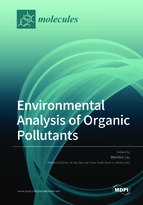Environmental Analysis of Organic Pollutants
A special issue of Molecules (ISSN 1420-3049). This special issue belongs to the section "Green Chemistry".
Deadline for manuscript submissions: closed (30 June 2022) | Viewed by 44991
Special Issue Editor
Interests: organic pollutants; POPs; sediment, soil contaminants; air pollution; industrial emission; incineration emission; dioxins
Special Issues, Collections and Topics in MDPI journals
Special Issue Information
Dear colleagues,
In recent decades, the environmental impact of organic pollutants, especially persistent and emerging organic pollutants, has attracted extensive attention, and related research has developed rapidly. Research in organic pollutants is a popular topic in the environmental field. Industrial production and other human activities emit a large number of organic pollutants, which are widely distributed in air, water, sediment, soil, and other environmental media. A series of research projects has been carried out on the development of analytical methods for organic pollutants, the distribution of environmental media, environmental concentration, environmental fate, the exploration of new pollutants, and the non-target analysis of organic pollutants. The aim of this Special Issue is to collect original research papers and review articles focused on the abovementioned aspects of organic environmental pollutants.
Prof. Dr. Wenbin Liu
Guest Editor
Manuscript Submission Information
Manuscripts should be submitted online at www.mdpi.com by registering and logging in to this website. Once you are registered, click here to go to the submission form. Manuscripts can be submitted until the deadline. All submissions that pass pre-check are peer-reviewed. Accepted papers will be published continuously in the journal (as soon as accepted) and will be listed together on the special issue website. Research articles, review articles as well as short communications are invited. For planned papers, a title and short abstract (about 100 words) can be sent to the Editorial Office for announcement on this website.
Submitted manuscripts should not have been published previously, nor be under consideration for publication elsewhere (except conference proceedings papers). All manuscripts are thoroughly refereed through a single-blind peer-review process. A guide for authors and other relevant information for submission of manuscripts is available on the Instructions for Authors page. Molecules is an international peer-reviewed open access semimonthly journal published by MDPI.
Please visit the Instructions for Authors page before submitting a manuscript. The Article Processing Charge (APC) for publication in this open access journal is 2700 CHF (Swiss Francs). Submitted papers should be well formatted and use good English. Authors may use MDPI's English editing service prior to publication or during author revisions.
Keywords
- organic pollutants
- POPs
- emerging contaminants
- sediment contaminants
- soil contaminants
- water pollutants
- air pollution
- industrial emission







